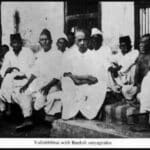Table of Contents
About Flag Movement or Jhanda Satyagraha in India | UPSC – IAS
Years ago, every princely state in India had its own flag and emblem. Today we have only one flag. How did it come into existence?
Though the participants of the 1857 Revolt carried a flag, it was Sister Nivedita, Vivekananda’s Irish disciple, who first thought of designing a national flag. The flag which was displayed at the 1906 Calcutta session of the Congress was square-shaped with 108 oil lamps along its borders and Indra’s thunderbolt (Vajra) in the centre. The words ‘Vande Mataram’ appeared on it in Bengali.
In 1916, Pingali Venkayya, a youth from Masulipatnam in Andhra Pradesh, started the Indian National Flag Mission and authored a book called “A National Flag for India.” He approached Gandhiji with his design – a tricolour in white, green and red with a blue charkha in the middle. Thus was born the first truly ‘national’ flag. The British of course, saw it as a symbol of revolution and prohibited it from being flown in public places.
The Jabalpur and Nagpur jhanda Satyagraha was organised to protest against this repression in 1923. Thousands of people courted arrest after taking the flag in procession. The flag became a symbol of India’s aspiration for freedom.
The first public flag hoisting ceremony was held on the afternoon of August 15, 1947 at India Gate. According to Lord Mountbatten, when Pandit Nehru unfurled the flag, a rainbow magically appeared in the cloudless summer sky. Surely, a heavenly salute for a hard-won flag.
Jhanda Satyagraha in India | UPSC – IAS
Jhanda satyagraha (also known as flag movement) were one of the most common acts of defiance during the nationalist rebellions led by Gandhi and the Indian National Congress throughout the struggle. The nationalist flag was regularly heralded by large processions and nationalist crowds.
In India, Jhanda Satyagraha is a campaign of peaceful civil disobedience during the Indian independence movement that focused on exercising the right and freedom to hoist the nationalist flag and challenge the legitimacy of the British Rule in India through the defiance of laws prohibiting the hoisting of nationalist flags and restricting civil freedoms.
The hoisting of nationalist flags over private and public buildings or government buildings had been a common nationalist act of defiance, especially with the Revolutionary movement for Indian independence and the members of the revolutionary Gadar Party. Such acts of defiance gained popularity across India with the rise of nationalist leaders such, Bipin Chandra Pal and Lala Lajpat Rai.
Jhanda Satyagrahas were conducted most notably in the city of Jabalpur and Nagpur in 1923 but also in many other parts of India.
- Proliferating during the Non-cooperation movement (1920-1922) and a prominent element of the Salt Satyagraha (1930) and the Quit India movement (1942), this means of revolt combined the hoisting of the nationalist flag with the technique of Satyagraha – non-violent civil disobedience – as pioneered by Mahatma Gandhi.
- Nationalists were encouraged to violate the law and hoist the flag without resisting arrest or retaliating against police.
Jhanda satyagraha in Jabalpur (1923) | UPSC – IAS
- The tussle began when Congress members On 8 March 1923, when the flag was waved at the municipal building, the European Deputy Commissioner was enraged and ordered to take down the flag. This resulted in the flag movement . In violation of the government ban, some volunteers along with Subhadra Kumari Chauhan, Nathuram Modi, took out a procession with a flag.
Jhanda satyagraha in Nagpur (1923) | UPSC – IAS
The nationwide movement was led by Sardar Vallabhai Patel. To suppress this movement, the British government started imprisoning the agitators. Historians say that the British government left no stone unturned to suppress the movement. By August 15, 1923, About 17 hundred agitators were jailed in the four-month-long agitation. The movement finally ended in Nagpur on 17 August.
- This movement was significant because instead of the British flag, the agitators hoisted the country’s flag in this movement.
- In the end, the British negotiated an agreement with Vallabhbhai Patel and other Congress leaders permitting the protestors to conduct their march unhindered and obtaining the release of all those arrested.
Jhanda satyagraha in Karnataka (1938) | UPSC – IAS
Other notable jhanda satyagrahas were organised in Mysore (now in Karnataka) in 1938 known as Shivapur Dhwaja Satyagraha. Under leadership of T.Siddalingaya president of Mysore Congress.
- The first conference of Mysore congress was conducted in 1938 at Shivapura. The conference has decided to organize a great satyagraha in Shivapura. T. Siddalingaya was elected as the president of the committee for the satyagraha.
- Realising the trouble, the Mysore administration banned any meeting within three kilometers from the city and prohibited the hoisting of tricolour flag.
- On 8th April 1938, T. Siddalingaya was taken in procession in a bullock cart in which around 10000 people participated.
- The participants proclaimed their faith in the leadership of Gandhiji. The flag was hoisted on 9th April 1938 by T. Siddalingaya. He was then arrested by the police. This incident is known as the Shivapura Dhwaja Satyagraha.
- As a part of state-wide Satyagraha, the flag was hoisted at Vidurashwatha in Kolar district of Mysore state, 33 people were killed in open police firing.


